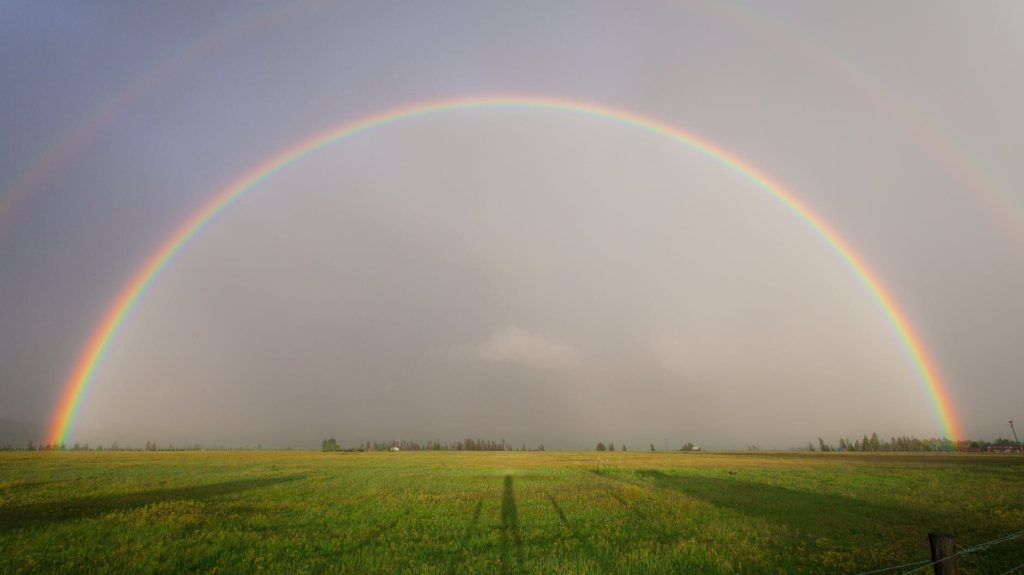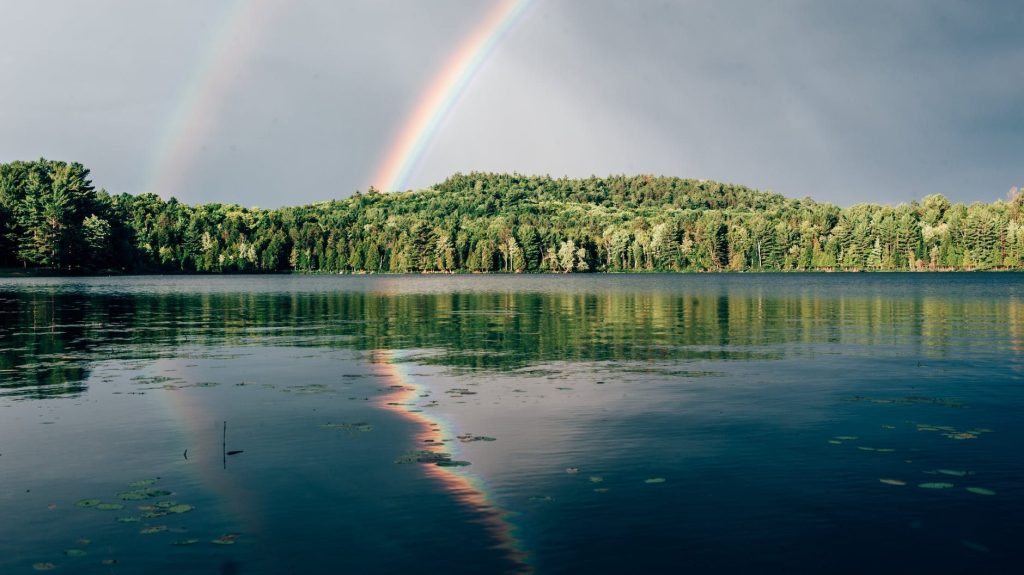We have entered the micro-season of “The First Rainbow Appears”. This is the third micro-season of the mini-season of Clear and Bright.
Each mini-season contains three micro-seasons. The micro-seasons contained within Clear and Bright are:
- The Swallows Arrive (April 04 – April 08)
- Geese Fly North (April 09 – April 13)
- The First Rainbow Appears (April 14 – April 20)
These seasons were established in 1685 by Japanese astronomer Shibuka Shunkai and are specific to Japan. However, just because the calendar focuses on Japan doesn’t mean it isn’t applicable to others. No matter where you live you can use these seasons as a starting point for your personal exploration of the world around you.
How are rainbows formed?
Rainbows are created when light is reflected and refracted through water droplets that are suspended in the air. The light’s reflection and refraction create a multi-colored visual arc that is suspended in the sky.
Although rainbows are commonly associated with rainstorms they can also be seen in fog, sea spray, or around waterfalls. In order to see a rainbow, the light source, which is usually the sun, needs to be behind the viewer and that light needs to strike the water droplets at a 42-degree angle. The arc of the rainbow forms around an imaginary point known as the anti-solar point. The anti-solar point is a point directly opposite the light source.(1)
Rainbows are circular in construction, but viewers can only see the reflected light above the horizon.(2) It is possible to see full circular rainbows if you are in an airplane.
The colors of the rainbow are a result of the reflected and refracted light. The color red, which has the longest wavelength, is seen at the outer edge of the rainbow. Whereas violet, which has the shortest wavelength, is seen as the inner-most color edge of the rainbow.
As the eye moves inward past the color violet the sky seems brighter. This is because our eyes see white when all the colors of the rainbow get mixed together.
Types of Rainbow:
A rainbow with a single arc is called a primary rainbow. This type of rainbow is what many people think of when they think about rainbows.
After the primary bow, there is the double rainbow. A double rainbow is created when the light is refracted twice within a raindrop.(1) This secondary rainbow’s colors are reversed with red on the inside and violet on the outside. In theory, all rainbows have a secondary or double rainbow.(2) However, the secondary rainbow is usually so faint it isn’t visible.
There is also a twinned rainbow. A twinned rainbow is different than a double rainbow because the rainbows are a twinned pair with the colors in the same order. These two rainbows are thus two distinct primary rainbows instead of a primary and secondary rainbow.
Other classifications of rainbows include:
Supernumerary rainbows: A Supernumerary rainbow is one where a pastel-colored arc forms inside the violet band of the primary rainbow. The colors in the supernumerary rainbow are usually pink, purple, and green in color.
Reflection Rainbow: These rainbows appear over large bodies of water and are the result of the light first reflecting off the water and then hitting the raindrops.
Reflected Rainbow: A reflected rainbow is different than a reflection rainbow because the primary rainbow is reflected in the water surface below.
Monochrome rainbow: A monochrome, or red, rainbow usually happens at dawn or dusk when the shorter wavelength colors get scattered into the atmosphere. Once these shorter wavelength colors are scattered, only the higher wavelength color (the red color) is visible.
Moonbow: A moonbow, or lunar bow, is a rainbow that is a result of the reflected moonlight. A full moon is usually needed for a moonbow and they are much dimmer than a solar rainbow.

Poems about Rainbows
Our first poem about rainbows comes from Emily Dickison (1830-1886). The poem is titled, “The rainbow never tells me”(97).
“The rainbow never tells me” (97) by Emily Dickinson
The rainbow never tells me That gust and storm are by, Yet is she more convincing Than Philosophy. My flowers turn from Forums — Yet eloquent declare What Cato couldn't prove me Except the birds were here!
In this poem, Dickinson seems to be talking about the knowledge that is embedded in nature. By referencing Cato, which is most likely a reference to Marcus Porcius Cato, she is also declaring the limits of human’s ability to make sense of the world.
Marcus Porcius Cato (95 BC – 46 BC) is also known as Cato the Younger. The epitaph “The Younger” distinguishes him from his father who is known as Cato the Elder. Cato the Younger was an orator, stoic philosopher, and Roman Senator. He was said to have great moral integrity, stubbornness, and tenacity. He is also known for his conflict with Julius Caesar.(3)
Dickinson has a few other poems about rainbows including “Some Rainbow — coming from the Fair!”(64), “We shall find the Cube of the Rainbow”(1484), and “On this long storm the rainbow rose”(194). They are all worth reading if you have the time.
The haiku for today come from Kobayashi Issa (1763-1828) and Takahama Kyoshi (1874-1959). Issa’s haiku are specific to this season.
first rainbow new leaves in their glory! Shinano mountain -Issa
a noon nap on a good day... first rainbow -Issa
Takahama Kyoshi haiku, although not specifically for this season, felt like a nice one to end today’s post on rainbows.
The rainbow stands As if you are here In a moment. -Takahama Kyoshi
Resources:
- “Rainbow”: Wikipedia
- “Rainbow”: National Geographic Society Encyclopedia
- “Cato the Younger”: Wikipedia
- Takahama Kyoshi: “The rainbow stands”; Masterpieces of Japenese Culture
Issa haiku was found on Haiku Guy by David G. Lanoue.
Want to support our work? Visit the Naturalist Weekly bookstore and browse our curated lists of books on poetry and haiku. Or pick up a gift card that can be used throughout the store.
Naturalist Weekly accepts donations for coffee and journals. Your support will keep both the coffee and content flowing.

I’ve always found rainbows to be overrated. Ha,ha,ha. I’m still in the microseason “chorus of the frogs” which I do so love. While I stubbornly work in the cold Spring rain, sleet and hail, I have only the frogs to keep me company.
Hi Melanie, I would be so interested in seeing a moonbow or the monochrome bow. I don’t think I have ever seen one of those. Although I may have and just didn’t notice.
I heard my first spring peepers this morning while I was out with the dog. Migration season is coming up soon! It sounds like the rainy northwest is living up to its name!
Those do sound like interesting “bows” to see. I’ll have to see if I can find pictures of a moonbow. I’ve seen a lot of interesting phenmena sleeping outside a lot as a kid, but I don’t know that I’ve seen one either. I did wake up to a cow leaning over me once. I was on USFS land that was also used for free-range gazing. Hahaha.
That must have been a little intense. Cows are big animals. Especially if they are looking down on you. I had a frog hop on my face once when I was sleeping and it scared the heck out of me. The joys of the back country!
Ha,ha,ha. I bet the frog was surprised too! 🙂
So beautifully photoed this wonderful Rainbow 🌷🙏🌈
Thank you for sharing and Blessed Friday 👏😍🌷
Hi Thattamma, Thank you for your kind words and continued support. I hope you have a good weekend.
You are most welcome 🌷🙏🌷 Advance Happy Easter 👏♥️💐